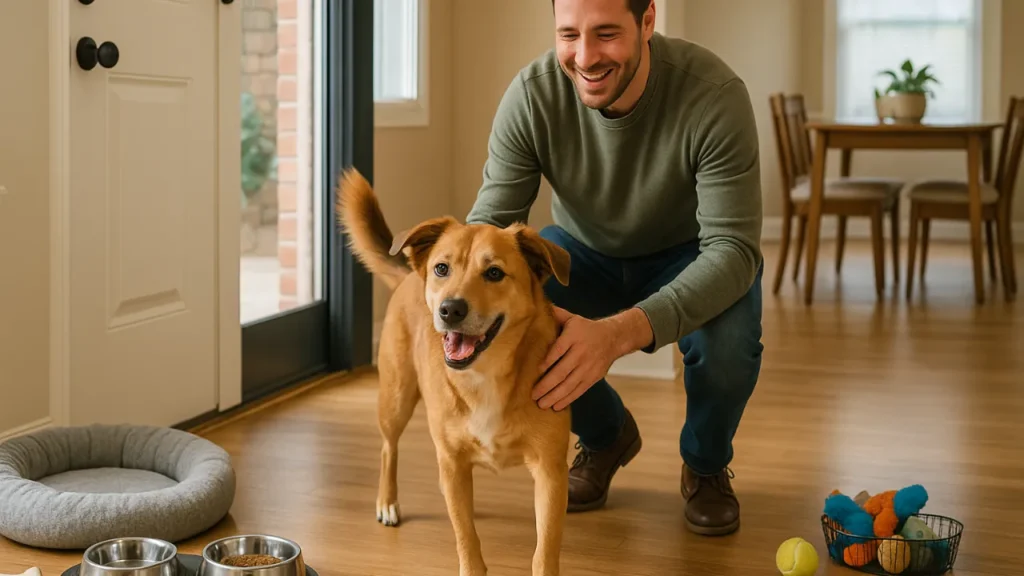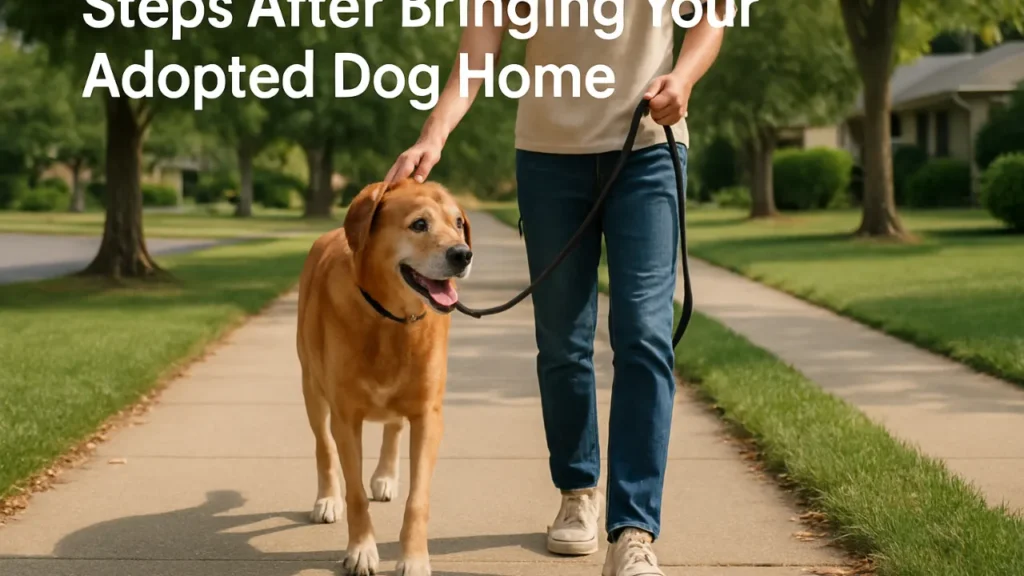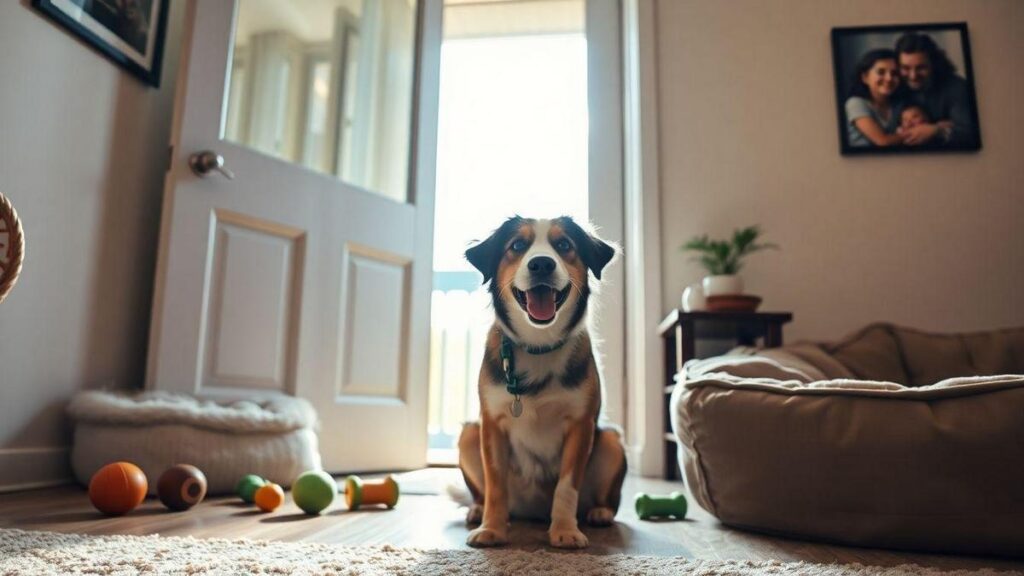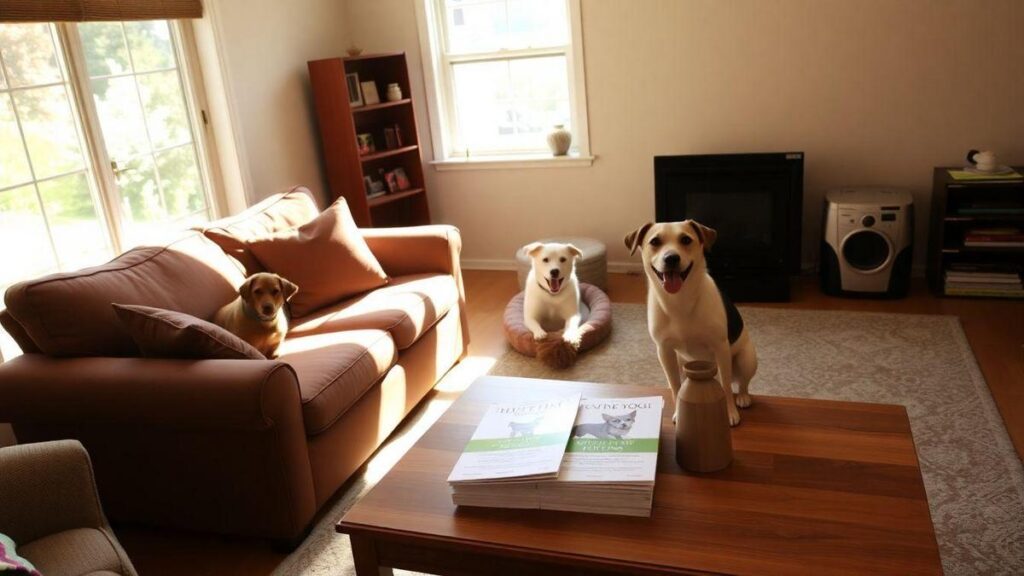Welcome Home! First Steps After Bringing Your Adopted Dog Home
Opening your heart and home to an adopted dog is truly one of the most rewarding experiences life can offer. That first car ride home, with those hopeful (and maybe slightly nervous) eyes looking back at you, is filled with so much anticipation and emotion. You’re starting a new chapter together! But once you walk through the door, what comes next? That initial period is crucial. Taking the right first steps after adopting a dog sets the stage for a smooth transition, helps your new companion feel safe and secure, and lays the foundation for a happy, trusting life together. It’s about patience, understanding, and creating a welcoming environment from moment one.

Remembering the first steps after adopting a dog is vital because your new friend is entering a completely unfamiliar world. They might have come from a shelter environment, a previous home, or even lived as a stray. Everything is new – the sights, the sounds, the smells, the people, the routines. It can be overwhelming and even scary for them. Your role in these initial hours, days, and weeks is to be their calm, patient guide. By managing introductions carefully, establishing predictable routines, and providing a safe space, you help them understand that they’ve finally landed somewhere loving and secure. This careful approach minimizes stress and helps prevent potential behavioral issues that can arise from a rocky start.
Summary
Preparing Your Home Before Your Adopted Dog Arrives
Bringing a new dog home isn’t just about opening the door; it requires some thoughtful preparation to ensure their safety and comfort from the very beginning. Getting your home ready before they arrive allows you to focus entirely on your new companion during those critical first moments.

Setting Up a Safe, Designated Space (Crate, Bed Area)
Every dog needs a place to call their own – a den where they can retreat and feel secure, especially when feeling overwhelmed. Before your dog arrives, set up this safe space. This could be a comfortable crate (never used for punishment!), a dog bed in a quiet corner, or even just a gated-off area. Equip it with soft bedding, a water bowl (if appropriate for the space), and perhaps a safe chew toy. Introduce them to this space calmly upon arrival, but don’t force them in. Let them explore it and understand it’s their personal sanctuary where they won’t be bothered. This designated area is crucial during the initial decompression period.
Dog-Proofing Your Home (Removing Hazards)
Think like a curious toddler (with teeth!). Get down on your dog’s level and look for potential hazards. Secure loose electrical cords, put away toxic cleaning supplies and medications, ensure houseplants are non-toxic, and remove any small objects they could chew on and swallow (like children’s toys, shoes, remote controls). Check that window screens are secure and that trash cans have lids. Even if your adopted dog is an adult, they might chew out of stress or curiosity in a new environment. Thorough dog-proofing prevents accidents and keeps your new friend safe as they explore their surroundings.
Gathering Essential Supplies (Food, Water Bowls, Leash, Collar/Harness, ID Tag)
Have everything you need ready before pickup day. This includes:
- Food: Get the same food the shelter or rescue was feeding, at least initially, to avoid sudden dietary changes that can cause stomach upset. You can gradually transition to a different food later if desired, following your vet’s advice.
- Bowls: Sturdy, appropriately sized food and water bowls (stainless steel or ceramic are often recommended).
- Collar/Harness: A properly fitting flat collar or harness. Ensure it fits snugly but allows you to slip two fingers underneath.
- ID Tag: An identification tag with your name and phone number attached to the collar is essential, even if the dog is microchipped.
- Leash: A standard 4-to-6-foot leash (avoid retractable leashes initially).
- Crate/Bedding: As mentioned above.
- Poop Bags: A necessity for walks!
- Basic Grooming Supplies: A brush appropriate for their coat type.
- Baby Gates (Optional): Useful for restricting access to certain areas initially. Having these items on hand avoids last-minute scrambles and ensures you can meet your dog’s basic needs immediately.
The First Few Hours: Calm and Quiet Introduction
The moment you arrive home is pivotal. Resist the urge to overwhelm your new dog with too much excitement or too many introductions right away. Keep things calm, quiet, and predictable.
The Initial Potty Break Outside
Before even going inside your home, take your new dog (on leash) directly to the designated potty spot in your yard or the area where you want them to eliminate. Give them plenty of time to sniff around and relieve themselves. Offer quiet praise and maybe a small treat if they go. This helps establish the routine from the very start and minimizes the chance of an accident right inside the door. Repeat this frequently, especially in the first few days.
Letting Your Dog Explore on Their Terms (Leashed Inside Initially)
Once inside, keep your dog on leash for the initial exploration of the main living areas where they’ll be spending time. This gives you control and prevents them from darting into unsafe areas or becoming overwhelmed by too much space at once. Let them sniff and investigate at their own pace. Avoid forcing interactions. Show them their designated safe space and where their water bowl is located. Keep the environment calm – low voices, no loud noises or sudden movements.
Keeping Introductions to Family Members Calm and Gradual
If you have other family members (including children), introduce them one at a time in a calm, controlled manner. Instruct everyone, especially children, to approach slowly, avoid direct eye contact initially (which can be intimidating), and let the dog initiate interaction (like sniffing their hand). Supervise all interactions closely, especially with children, teaching them gentle handling. Avoid having lots of visitors over in the first few days; give your dog time to adjust to their immediate family first.
The First Days and Weeks: Establishing Routine and Trust
The initial adjustment period is all about building trust and predictability. Consistency is your best friend during this time. These first steps after adopting a dog set the pattern for your future relationship.
Implementing a Consistent Feeding and Walking Schedule
Dogs thrive on routine. Establish set times for meals, potty breaks (especially important for house-training), and walks as quickly as possible. Take your dog out frequently, particularly after waking up, after eating, after playing, and before bedtime. Stick to the schedule as closely as possible, even on weekends. This predictability helps your dog understand what to expect, reducing anxiety and speeding up the house-training process.
Understanding the Decompression Period (The 3-3-3 Rule)
Many rescue organizations talk about the
“3-3-3 Rule” as a general guideline for what to expect:
- First 3 Days: Your dog may feel overwhelmed, scared, and unsure of their surroundings. They might not eat much, hide, or test boundaries. Focus on providing a calm, safe space and establishing basic routines.
- First 3 Weeks: Your dog starts to settle in, learning the routine and figuring out their new environment. Their true personality begins to emerge. You might see some behavioral issues surface as they become more comfortable. Consistency and patience are key.
- First 3 Months: Your dog should feel more at home and secure. They’ve likely built trust with you and understand the household rules. This is when you truly start to feel like a bonded family. This is just a guideline, and every dog adjusts at their own pace, but it helps manage expectations.

Starting Basic Training with Positive Reinforcement
Begin basic manners training early on, but keep sessions short, positive, and fun. Focus on essentials like sit, stay, come, and loose-leash walking. Use positive reinforcement methods – rewarding desired behaviors with treats, praise, or toys. Avoid punishment or harsh corrections, especially during this sensitive adjustment period, as it can damage trust and increase anxiety. Building a positive association with training strengthens your bond.
What is Brain Training For Dogs?
Do you know the Brain Training for Dogs? you gain access to a unique approach that develops your dog’s intelligence through simple and effective games. You will notice real changes in behavior, less stress in everyday life and a much more harmonious relationship. And the best: everything at your own pace, with clear instructions, without having to leave home. It is the ideal solution for those who seek lasting results with affection and respect
Introducing New Experiences Slowly
While socialization is important, avoid overwhelming your new dog with too much too soon. Introduce new people, places, sounds, and other animals gradually and in controlled settings. Watch your dog’s body language closely for signs of stress (lip licking, yawning, whale eye, tucked tail) and remove them from the situation if they seem overwhelmed. Positive, controlled exposure is much more effective than flooding them with stimuli.
Essential First Steps for Health and Safety
Beyond the initial settling-in period, taking care of your new dog’s health and ensuring their safety identification are crucial immediate steps.
Scheduling the First Vet Visit (Check-up, Vaccinations, Microchip)
Schedule a wellness check-up with a veterinarian within the first week or two of adoption. Even if the shelter provided initial vetting, establishing care with your own vet is important. Bring any medical records provided by the rescue. Your vet will perform a thorough physical exam, confirm vaccination status, discuss parasite prevention (fleas, ticks, heartworm), check the microchip registration, and address any immediate health concerns. This visit establishes a baseline for your dog’s health.
Discussing Diet and Nutrition with Your Vet
While you started with the food provided by the shelter, discuss your dog’s long-term nutritional needs with your vet during the initial visit. They can recommend a high-quality food appropriate for your dog’s age, breed, size, activity level, and any specific health conditions. If you decide to switch foods, your vet can advise on how to transition gradually over 7-10 days to avoid digestive upset.
Ensuring Proper Identification (Tags and Microchip Registration)
This is non-negotiable for safety. Ensure your dog wears a collar with a clearly legible ID tag displaying your current phone number and possibly your address at all times. Additionally, verify that the microchip information is registered to you with your correct contact details. Shelters often register the chip initially, but you need to update the registry with your information. A microchip is a permanent form of ID, but the tag provides immediate contact information if your dog gets lost.
Patience and Understanding: Building a Lifelong Bond
The most important ingredient in successfully integrating an adopted dog is patience. Building trust and a strong bond takes time, consistency, and understanding.
Recognizing Signs of Stress or Anxiety
Learn to read your dog’s body language. Subtle signs of stress can include excessive panting, lip licking, yawning when not tired, avoiding eye contact, a tucked tail, flattened ears, or trembling. Recognizing these signs allows you to remove your dog from stressful situations or provide comfort and reassurance before their anxiety escalates.
Celebrating Small Victories
Acknowledge and celebrate the milestones, no matter how small. The first time they willingly go into their crate, the first accident-free day, the first time they greet you enthusiastically at the door – these are all signs of progress. Positive reinforcement and celebrating successes build confidence in both you and your dog.
Giving Your New Companion Time to Adjust
Remember the 3-3-3 rule (or longer!). Don’t expect perfection overnight. Your adopted dog has been through significant changes. Give them the time, space, and consistent loving guidance they need to blossom in their new home. Be patient with setbacks, stay positive, and focus on building a relationship based on trust and mutual respect.
Taking these first steps after adopting a dog thoughtfully and patiently creates a positive foundation for your life together. It shows your new companion that they are safe, loved, and finally home.

Key Takeaways:
- Prepare your home before bringing your adopted dog home by setting up a safe space, dog-proofing, and gathering essential supplies.
- Keep the initial homecoming calm; introduce the potty spot first, allow leashed exploration inside, and manage introductions to family members gradually.
- Establish consistent routines for feeding, walking, and potty breaks immediately.
- Understand the 3-3-3 rule for decompression and be patient as your dog adjusts.
- Schedule a vet visit within the first week for a check-up, vaccinations, and microchip verification.
- Ensure proper ID tags and microchip registration with your current contact information.
- Use positive reinforcement for training and introduce new experiences slowly.
- Be patient, understand their potential stress, and celebrate small victories to build a strong, trusting bond.
Ready to transform your dog’s behavior in a fast and fun way? With Brain Training for Dogs, you have immediate access to a proven method that has helped thousands of owners like you. No more frustration – start today and see the difference in the first few days!
Ready to see real results? Click below to get instant access to the Brain Training for Dogs program and start your transformation today!
**Sidnir Vieira**
Founder of TechHavela
A passionate pet and tech content creator, helping dog owners across the U.S. make smarter decisions for their furry friends.



